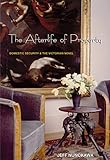The Afterlife of Property : Domestic Security and the Victorian Novel / Jeff Nunokawa.
Material type: TextPublisher: Princeton, NJ : Princeton University Press, [2009]Copyright date: ©1994Edition: Course BookDescription: 1 online resource (160 p.)Content type:
TextPublisher: Princeton, NJ : Princeton University Press, [2009]Copyright date: ©1994Edition: Course BookDescription: 1 online resource (160 p.)Content type: - 9780691114675
- 9781400824632
- 828.8
- PR878
- online - DeGruyter
- Issued also in print.
| Item type | Current library | Call number | URL | Status | Notes | Barcode | |
|---|---|---|---|---|---|---|---|
 eBook
eBook
|
Biblioteca "Angelicum" Pont. Univ. S.Tommaso d'Aquino Nuvola online | online - DeGruyter (Browse shelf(Opens below)) | Online access | Not for loan (Accesso limitato) | Accesso per gli utenti autorizzati / Access for authorized users | (dgr)9781400824632 |
Browsing Biblioteca "Angelicum" Pont. Univ. S.Tommaso d'Aquino shelves, Shelving location: Nuvola online Close shelf browser (Hides shelf browser)

|

|

|

|

|

|

|
||
| online - DeGruyter Religion in American Politics : A Short History / | online - DeGruyter Science and Polity in France : The End of the Old Regime / | online - DeGruyter The Machiavellian Moment : Florentine Political Thought and the Atlantic Republican Tradition / | online - DeGruyter The Afterlife of Property : Domestic Security and the Victorian Novel / | online - DeGruyter From Subsistence to Exchange and Other Essays / | online - DeGruyter The World of Prometheus : The Politics of Punishing in Democratic Athens / | online - DeGruyter The Athenian Nation / |
Frontmatter -- Contents -- Acknowledgments -- CHAPTER ONE. Introduction -- CHAPTER TWO. Domestic Securities: Little Dorrit and the Fictions of Property -- CHAPTER THREE. For Your Eyes Only: Private Property and the Oriental Body in Dombey and Son -- CHAPTER FOUR. Daniel Deronda and the Afterlife of Ownership -- CHAPTER FIVE. The Miser's Two Bodies: Sexual Perversity and the Flight from Capital in Silas Marner -- Afterword -- Notes -- Works Cited -- Index
restricted access online access with authorization star
http://purl.org/coar/access_right/c_16ec
In The Afterlife of Property, Jeff Nunokawa investigates the conviction passed on by the Victorian novel that a woman's love is the only fortune a man can count on to last. Taking for his example four texts, Charles Dickens's Little Dorrit and Dombey and Son, and George Eliot's Daniel Deronda and Silas Marner, Nunokawa studies the diverse ways that the Victorian novel imagines women as property removed from the uncertainties of the marketplace. Along the way, he notices how the categories of economics, gender, sexuality, race, and fiction define one another in the Victorian novel. If the novel figures women as safe property, Nunokawa argues, the novel figures safe property as a woman. And if the novel identifies the angel of the house, the desexualized subject of Victorian fantasies of ideal womanhood, as safe property, it identifies various types of fiction, illicit sexualities, and foreign races with the enemy of such property: the commodity form. Nunokawa shows how these convergences of fiction, sexuality, and race with the commodity form are part of a scapegoat scenario, in which the otherwise ubiquitous instabilities of the marketplace can be contained and expunged, clearing the way for secure possession. The Afterlife of Property addresses literary and cultural theory, gender studies, and gay and lesbian studies.
Issued also in print.
Mode of access: Internet via World Wide Web.
In English.
Description based on online resource; title from PDF title page (publisher's Web site, viewed 30. Aug 2021)


